If you spend a lot of time thinking and learning about sandwiches, you’ll eventually come to the conclusion that your life just won’t be complete without the ability to make perfect deli meats at home. Think of it! Perfect, sliced pastrami layered on homemade rye bread. Smoky ham with pickles, coarse mustard, and melted swiss. Italian beef, spicy with giardiniera. Beef on weck—horseradishy. Homemade French dip sandwiches.
Why not? Why not have all the sandwiches, even though you don’t live in Chicago, Buffalo, or France? (Isn’t that where French dips come from? No?) But if you’re buying your roast beef from your grocery store deli, you can only get so fresh, so high-quality cuts. And you can generally forget pink, medium-rare beef. Ham, yes, but good roast beef? Hardly.
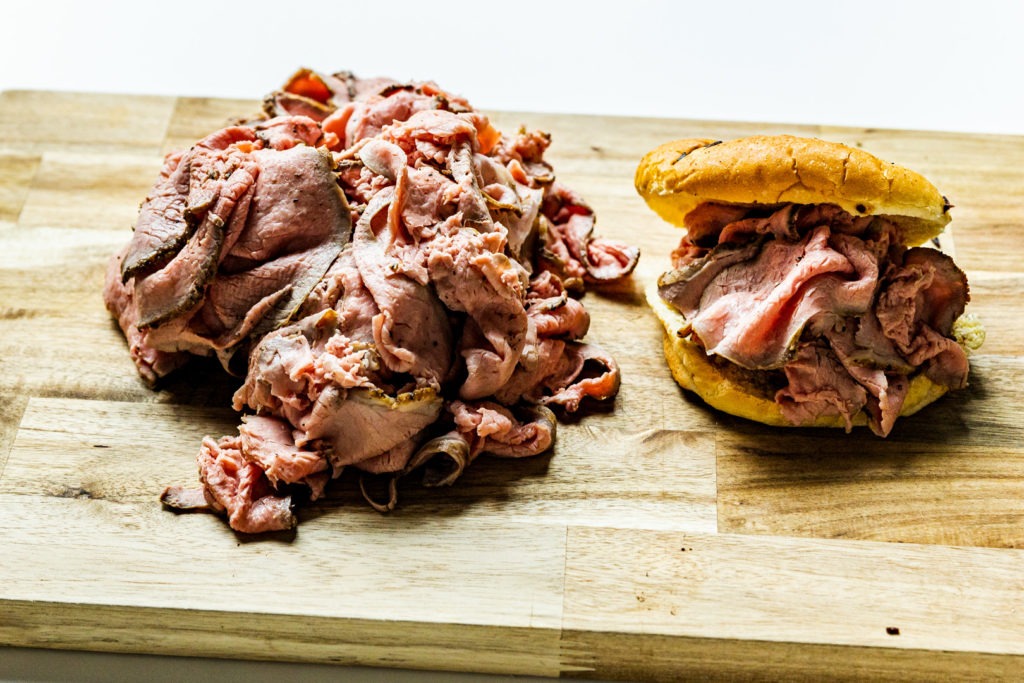
Yes, the sandwich life demands better meats. It demands you make your own. Here, we’ll show you the basics of making deli-style roast beef at home. It is, of course, a temperature game—but it’s one that’s easy to win. We’ll take you all the way through the process, and by the end you’ll be thinking about how shelling out $3–11k for a vintage-style, hand-crank deli slicer doesn’t sound all that bad. (Don’t do it…you don’t need it.)
What beef to use for homemade deli roast beef?
There is a little debate about the best cut for deli roast beef. The main contenders are top sirloin, the eye of round, and top loin (also called strip loin).(Some might argue for chuck or brisket, but for plain roast beef, those aren’t the right answer. Brisket is great for pastrami and corned beef, but for rare or medium-rare roast beef, stick to leaner the leaner cuts with big, beefy flavor. Save chuck for other things altogether.) Top sirloin is full of deep, mineraly, beefy flavor, and is a great contender. Strip loin would be obviously delicious, but it will also cost a good deal more than eye of round or top sirloin.4
Eye of round has plenty of beefy flavor, is wonderfully lean, and has a pretty uniform shape. It’s kind of perfect for this project. I recommend you start with eye or top sirloin. Maybe get a strip loin for some very special sandwiches.
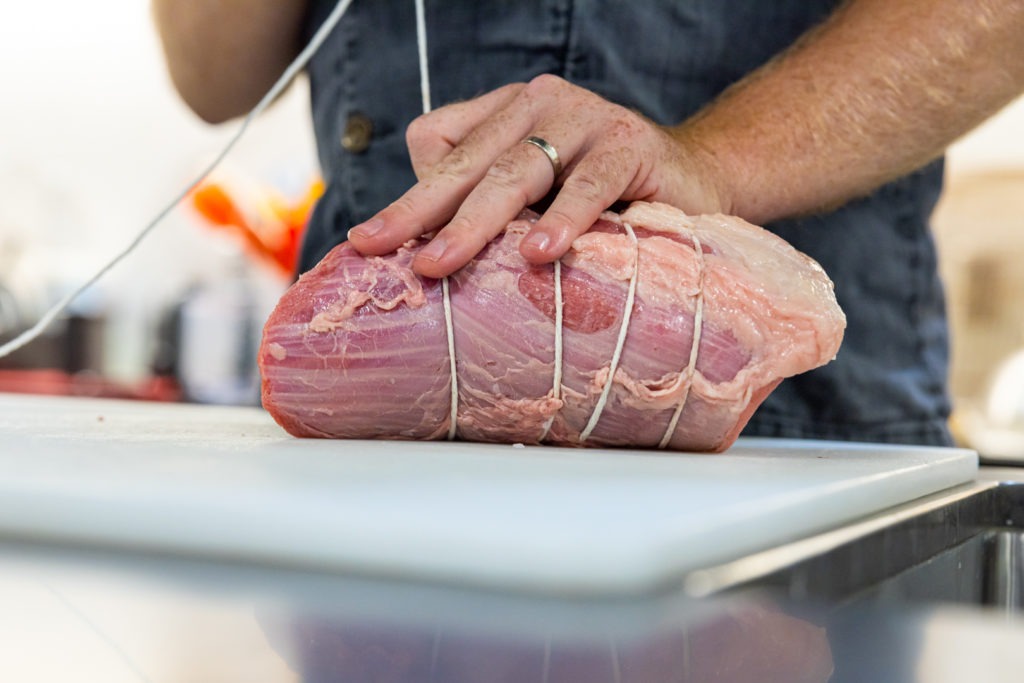
If you remember and have time for it, salt your beef roast, uncovered, in the fridge the night before you cook. This dry-brining will help tenderize the meat and make it juicier while also deepening the flavor.
How to cook deli-style roast beef
For the best roast beef, you want two things in your cooking: a quality sear and a perfect pinkness from edge to edge inside the roast.
The sear will give a deeper, meatier, roasted flavor. Without it, it’s just beef, not roast beef. And while there’s not a lot of that roasted portion on any given slice of beef, it’s essential for the right flavor. To get the sear right, heat a heavy skillet5 over high heat, put a little high smoke point oil in the pan, and sear all sides of the roast hard. Get a nice, rich brown on as many sides of the meat as you can. It doesn’t matter that the crust may fade during cooking; after all, this is going to be sliced very thinly.
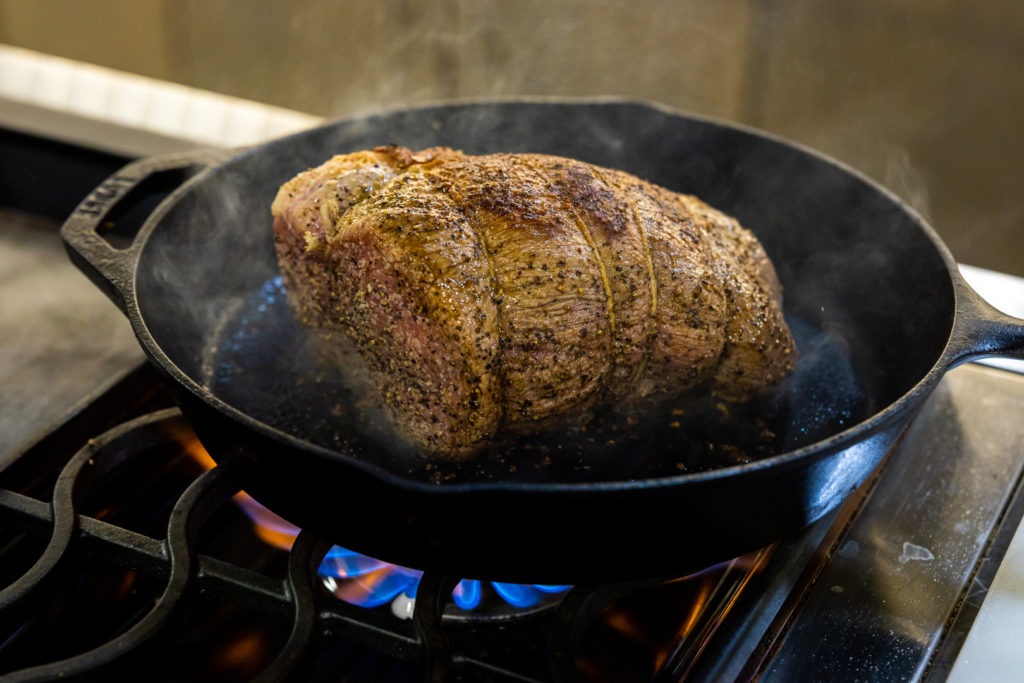
As for the perfect rosy color, that’s easily accomplished by slow-roasting the beef. This has two thermal advantages. The first, most obvious, advantage is that slow-roasting decreases the temperature gradients in the meat, as well as minimizing carryover cooking. That means you’re less likely to overcook the meat or end up with an unsightly gray band around the edge of your sliced roast beef. Using a leave-in probe like the ChefAlarm® will help you know when to take it out of the oven so that it’s temperature perfect every time you make it. Pulling the beef out of the oven at 130°F (54°C) will ensure a beautiful medium-rare after the 3–5°F (2–3°C) of carryover cooking you can expect from this roast.
But there is another advantage to lower, slower roasting—enzymatic action!6 As red meat comes up to temp more slowly, there are enzymes that activate and break down tougher connective proteins in the meat. The more slowly meat moves through the enzyme-activity zone, the more tender it will become. This is great because top sirloin and, especially, eye of round are not the very tenderest cuts on the cow. A slow roast at 200°F (93°C) will give you the perfect bite and texture for your sandwiches.
Cooling and slicing
They aren’t called “cold cuts” for nothing. Deli meats are kept cold not only to keep them from spoiling, but also because they cut better when cold than when hot. When a roast cools completely, most of the juice is locked back into the protein structure, and the cold fats become solid. The whole structure is more amenable to slicing than when the roast is hot.
To chill your roast for slicing and for storage, you can simply let it stand on the counter until it reaches near room temperature, then move it to the fridge for 3-5 hours or overnight. If you’re in a rush, you can seal the roast in a plastic bag and submerge it in an ice bath for significantly less time. There are a few sandwiches that call for hot slicing, but for the most part, cold slicing is the best way to go.
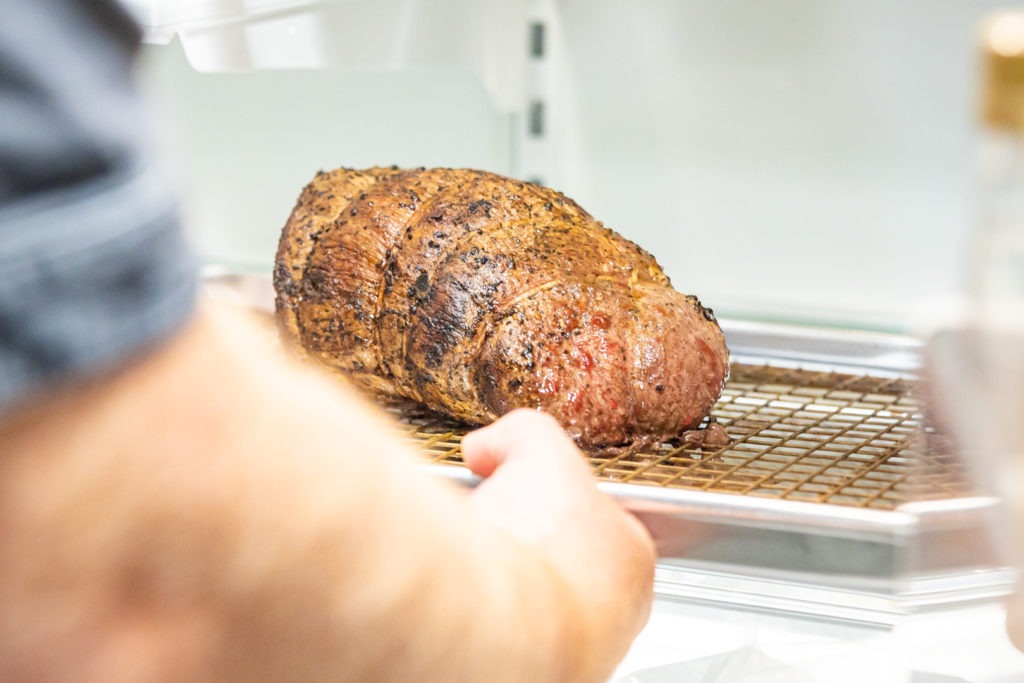
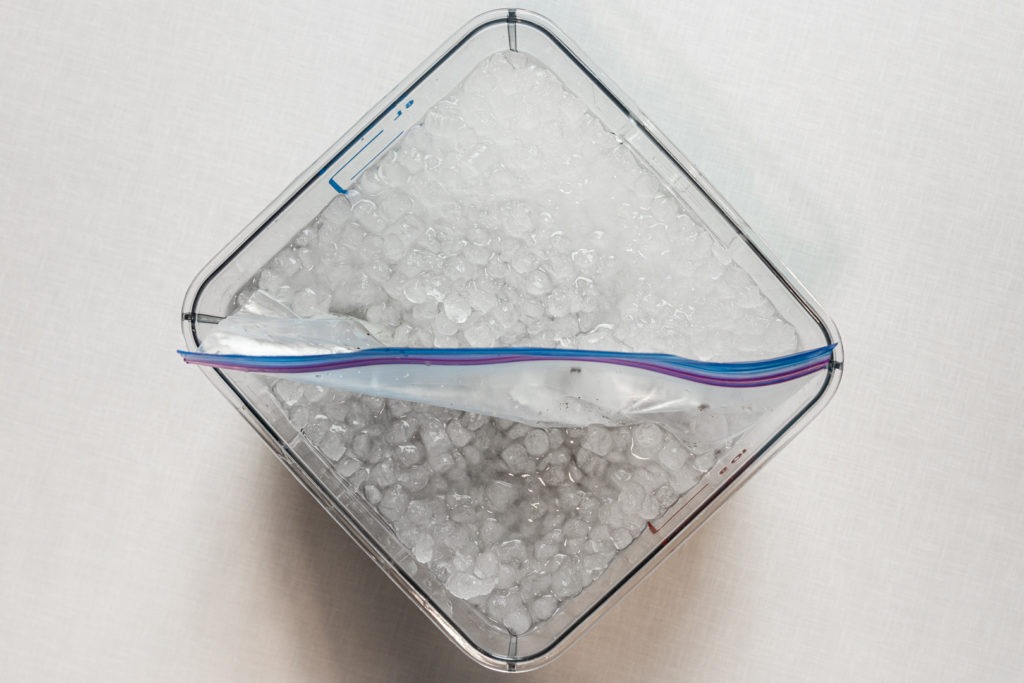
As for the slicing itself, you don’t need the $3–11k slicers I alluded to in the intro. I mean, I want one, but I don’t need one. You can get a decent deli slicer at many home-good stores, and even some sporting goods stores, for very decent prices. And if you need another reason to get one, consider homemade jerky—just a thought. Because slicers can be cumbersome to get out, set up, and wash, it’s not a bad idea to do up a roast or two, slice it all, and vac-pack some for the freezer.
But even without a mechanical slicer, a sharp slicing knife and a deft hand can still get you respectable sliced beef for your sandwiches. Just take the time to focus and do a good job. Your mouth will still thank you.
Print
Homemade Deli-style Roast Beef Recipe
Description
Make perfect roast beef for deli sandwiches at home. Based on instructions from Saveur.com
Ingredients
Instructions
- For best results, salt the roast liberally the night before cooking and leave it, loosely covered, in the refrigerator. This step is technically optional, but it is also strongly recommended.
- Preheat your oven to 200°F (93°C).
- If you salted the roast the previous night, give it a quick rinse (there will be too much salt). Apply salt, if needed, and pepper
- Heat a cast-iron skillet on the stove over high heat. When the pan is quite hot (use an infrared thermometer to take its temperature if you have one) add a little high smoke point oil to the pan and sear the roast all over until beautifully browned.
- Remove the roast from the pan and place it on a rack set into a cookie sheet.
- Insert the probe from a ChefAlarm into the center of the roast and place the roast in the oven to cook. Set the high-temp alarm on the ChefAlarm for 130°F (54°C).
- When the alarm sounds (it will probably be 90 minutes or more), test the doneness of the roast with your Thermapen® Mk4. If that test verifies doneness, remove the roast from the oven and let it cool.
- Once the roast is nearly room temperature, put it in the fridge overnight.
- Slice it to whatever thickness you like for your sandwich, pile it on the bread, and go to town. Enjoy!
Notes
If using other seasonings, herb rubs for instance, or sliced garlic cloves that are inserted into the flesh of the roast, it’s probably best to apply those after the sear. They will get in the way of the meat searing and any that are on the surface will not adhere well but will come off in the pan. Salt and pepper seem to handle it, but minced parsley will not.
Let your imagination run wild! Apply a coating of horseradish (which will lose its heat in the oven), use your favorite BBQ rub, use Montreal seasoning. Go for it.
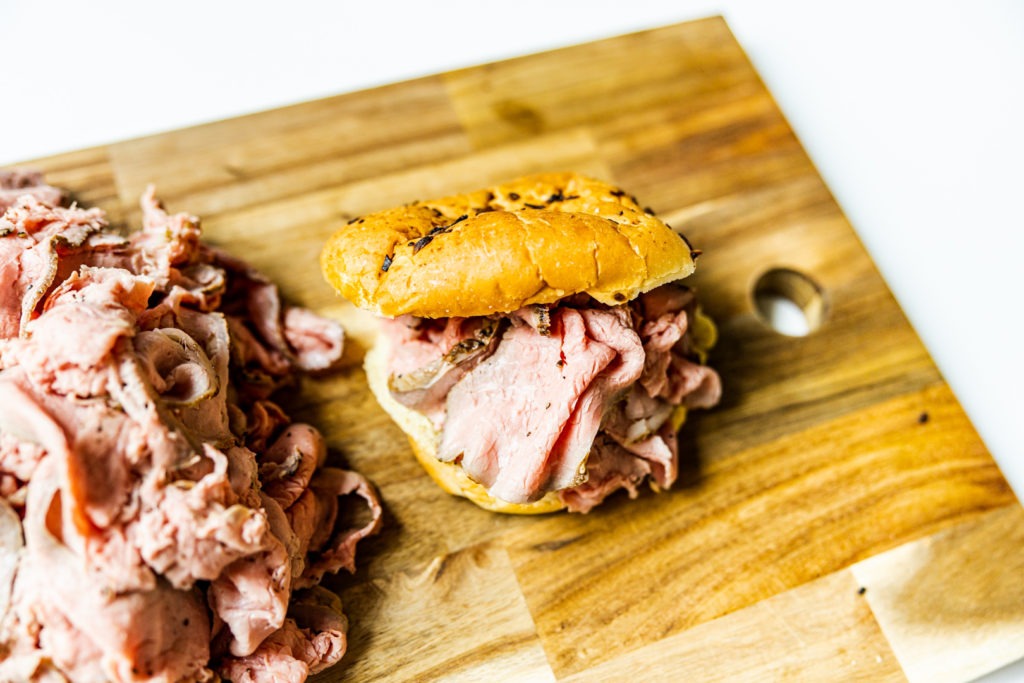
Roasting your own beef is incredible, not just because it’s cheaper than deli-bought, not just because it’s delicious, but because it’s your delicious. Make it to your doneness spec, season it how you like, and get it sliced the way you want it. Make up a whole roast, slice it all, and have Italian beef sandwiches for the family for dinner. Make sandwiches from cities you haven’t yet visited. Just load up a hoagie bun for lunch! No matter what, you’ll know it’s made just how you like it, because you used the ChefAlarm and Thermapen® to make sure the temps were spot on. And when the meat is perfect, the sandwich life really is the life you want to live.
Shop now for products used in this post:
Making your own deli meats should save you quite a bit per pound, by the way. Maybe you can use that fact to justify a slicer!↩
cat iron is best if you have it↩
Speaking of low/slow, if you wanted to smoke the beef for your roast beef, that’d be delicious. Follow the same temperature protocols, just change the cooking location from oven to smoker.↩
Making your own deli meats should save you quite a bit per pound, by the way. Maybe you can use that fact to justify a slicer!↩
cat iron is best if you have it↩
Speaking of low/slow, if you wanted to smoke the beef for your roast beef, that’d be delicious. Follow the same temperature protocols, just change the cooking location from oven to smoker.↩
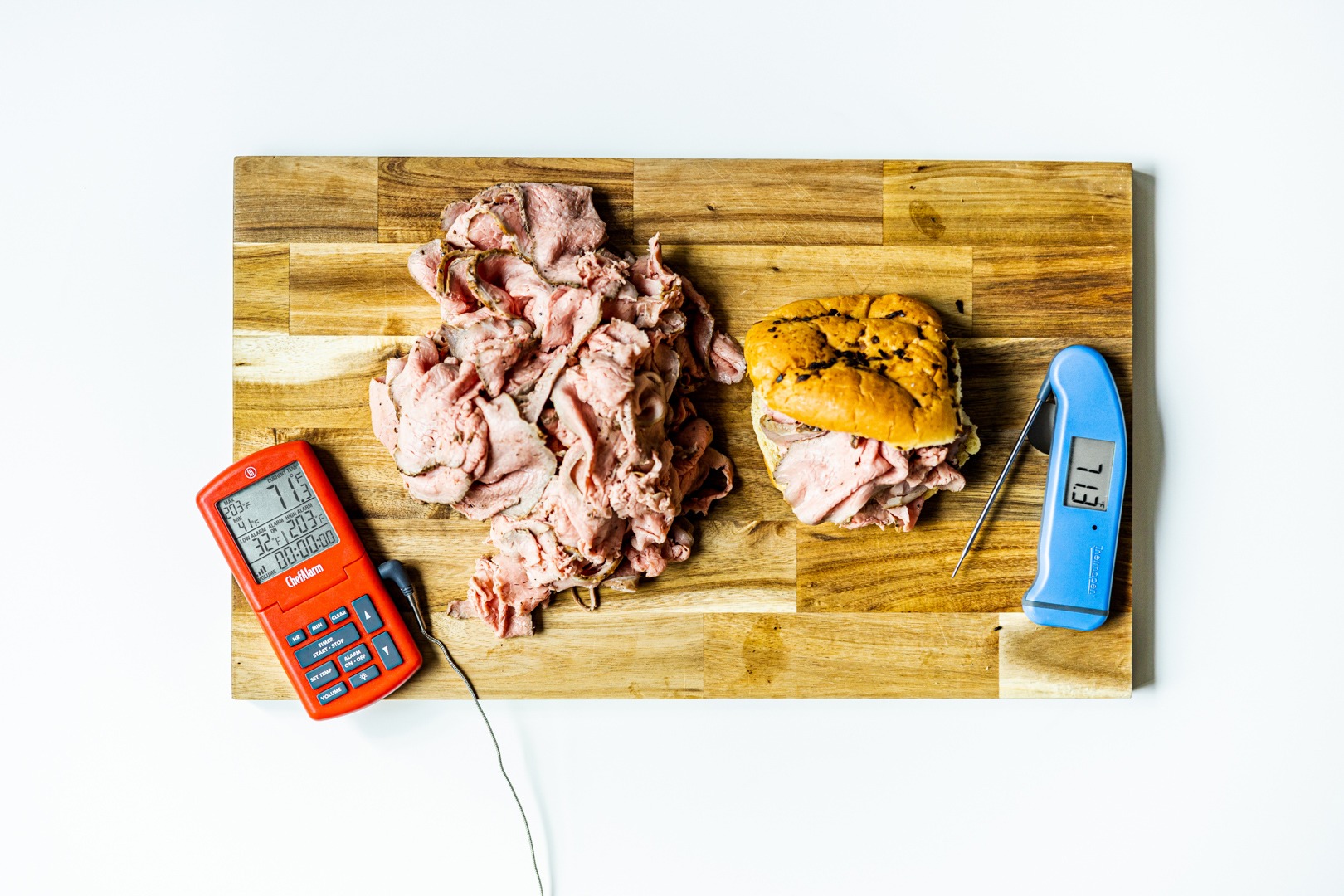
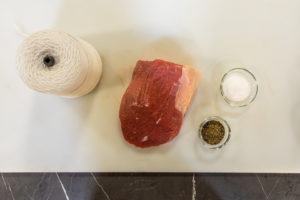
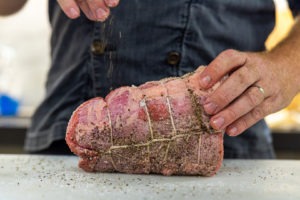
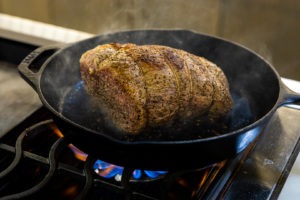
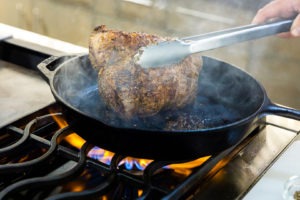
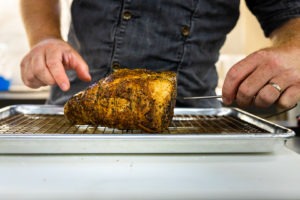

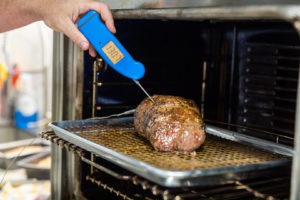
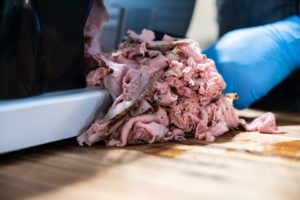

Barry P King King says
I have sliced a lot of different meats manually with very high grade steel for years. I started in a restaurant in high school 60 years ago and learned how kitchens (at least those that are old school) should function.
Using a good steel blade that is honed correctly will produce a very good slice, but it takes practice and the correct knife for the job. Oddly enough, I have always had much success with a 12″ non-serrated bread knife razor sharpened. However one needs different knives for the same job, some smaller such as an 8″ paring knife for tricky areas and removing bones in poultry.
That said, at my advancing age, it has become more difficult to manually fine slice cold meats due to arthritis. I am speaking of cold pastrami, corned beef, and turnkey all of which I make always using the slow cooking method (my taste is that it is done in a smoker or a coal-fired (indirect heat of course) grill). They are all properly brined, and in the case of pastrami, a procedure that occupies about 14 days and a lot of refrigerator room—but worth the wait!
For slicing cold meats down to extremely thin, and up to 1/4 inch I have used a Chef’s Choice Model 615 which I bought a few years back perhaps for $300 more or less. It works perfectly, although I suggest doing a lot of slicing in a single job since the clean up is somewhat time-consuming (removing the circular blade, etc).
For hot meats, I will always slice by hand with a proper honed blade.
I use a Thermopop as well as “Smoke” with alarm and was directed to your company several years ago by Amazing Ribs, of which I am one of the founding members “KINGBBQ.” The blogs there are tremendously helpful especially for anyone passionate about grilling.
Your products are most professional and I highly recommend them.
Ernest Horn says
130 is way to high of temperature nothing will be pink at that temperature
Pull out at 115-118 sit for 20mins it will be perfect
Martin says
Thank you for your comment! We pulled ours at 130°f and were delighted with the final color and tenderness of the product.
ChefFrank says
Was too dry at that temp. Maybe your thermometer is overstated?
Martin says
I’m sorry to hear it was too dry for you! If you knock 4 or 5 degrees off your finish temp, it will be more moist. We were going for a middle medium rare, it sounds like you like your roast beef more on the rare side, which is great!
EPOC says
I pulled it at 54C and it was perfect. Also, another alternative (better one) is to sous vide at 54C for 15 hours (set it and forget it)
Marilyn J Carini says
Can I cook it the whole time at 200 degrees in my smoker? Do you recommend a minimum time in the smoker and then save pellets by using the oven to finish it off? Can I skip the searing if I just salt it and smoke it?
Martin says
Marilyn,
Yes, you can cook it in the smoker the whole time, but if you want to save pellets by moving it to the oven, I’d give it a good 45 minutes in the smoke first. As for skipping the sear…I’m torn. I don’t think you’ll be in the smoker long enough to form up a good bark, so the sear would still be necessary. That being said, if you were in the smoker the whole cook, you might get enough bark to form that you won’t miss the browning as much.
Alan Tenpenny says
“When the pan is quite hot (use an infrared thermometer to take its temperature if you have one) “.
This seems like a strange statement coming from a thermometer company. Do you sell an infrared thermometer the reads “quite hot”? Come on man, give us a TEMPERATURE!
Martin says
Alan,
Right you are! You need a temperature of 425°F or higher for a good sear. The hotter the pan, the faster and deeper the sear, but nothing below 425°F is even worth your time.
Ruth Kahn says
If possible, recipe should suggest internal meat temps for medium, medium rare and rare as well as estimated cooking times for a typical size top sirloin or Eye of round roast The only internal temp given for the meat is 130, without description of done-ness.or length of roasting time
Martin says
Ruth,
Fair point! For medium, shoot for a final temp of 135°F. The total cooking time for one of these roasts should be about 2 hours, give or take.
Tom Merilo says
Eye of round is one cut of beef that I have found to be beyond redemption: tough but flavourless. Hence it is not even worth the effort of doing a 72 hour sous vide on it at, say, 136F.
I am surprised that you have mischaracterized this cut.
Martin says
I understand your feelings on this. But I have found it to make good roast beef for this purpose—we even used eye for our cold-cuts at the b utcher shop I used to work at. You can certainly apply the principles from this recipe to any cut that you like.
Farris Powell says
Ok now that we have the meat recipe. I need a good au jus recipe for French Dip sandwiches
Martin says
Sauté an onion in some butter. Sprinkle in a little fresh or dried parsley and a decent amount of black pepper. Deglaze the pan with some red wine or beef stock. Add more beef stock, then cook it to reduce by about half. Add salt to taste. I also like to sauté a pepper with the onion, sometimes I’ll throw in a little fennel seed (for Italian flair). This will, of course, be best with homemade beef stock, but if you don’t have any, use the best beef broth or stock you can find.
Lori Kostecki says
Thanks for the article! Do you recommend bringing the beef to room temp first before searing it?
Martin says
No, not really. With the low oven temp, the gradients will have time to smooth themselves out just fine. In fact, going with a cold roast might be even better. We learned about that while writing our How to Cook Perfect Prime Rib post.
Cecil Burkett says
If I do this per your recipe, how can I heat the meat up after slicing without drying it out.
Thanks
Martin says
I follow Kenji’s advice from SeriousEats: heat it gently in warm broth or jus. YOu can heat a pot of beef broth or beef jus to 120–140°F (check it with your Thermapen!) and drop the meat it, giving it a stir. You get a good interchange of flavors, and hot, juicy beef for your sandwich.
Stu Kinzler says
The only way to achieve the desired result is to use a “professional” quality electric slicing machine with a super-sharp blade. Eye round has been my cut of choice for many years.
Be sure to refrigerate the cooked meat thoroughly for at least 24 hours before cutting into it. Do not attempt to slice hot or warm meat. The difference in the amount of juice lost on the slicing machine will be astounding. Nothing will ruin a good piece of meat faster than trying to slice it while it’s hot or warm. It must be COLD!
Martin says
True!
Chelsea says
Hi, just wondering if you have a salt to meat weight ratio, or at least an average quantity of salt used for the dry brining? Thanks!
Martin says
Good question! I’d shoot for a 2–5% salt ratio.
Adk says
Great article. For slicing, I put it in the freezer until it gets firm but isn’t rock solid, then I slice it on a mandolin. You get very thin slices and it cuts fast. I suggest the Benriner jumbo. Way better than an electric slicer.
Martin says
I have a mandolin, and will have to try this out! Great advice.
Aaron Bredon says
You don’t need to spend thousands on a hand cranked slicer. There are quite a few commercial grade 10-inch blade deli slicers for around $400-600. KWS and Beswood are highly recommended by users, and there are others as well.
ruth campfield says
I HOPE to cook one of these tomorrow. Do I put it in a covered baking pan. Something like a dutch oven?????
I an not very successful with roast and really need this to be right.
I hope I’ll get a reply
Martin says
I’m sorry I didn’t see this comment sooner. No, you don’t put it in a covered pan, just a baking sheet does fine.